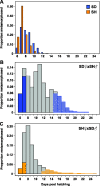Pervasive Mitonuclear Coadaptation Underlies Fast Development in Interpopulation Hybrids of a Marine Crustacean
- PMID: 33502469
- PMCID: PMC7947751
- DOI: 10.1093/gbe/evab004
Pervasive Mitonuclear Coadaptation Underlies Fast Development in Interpopulation Hybrids of a Marine Crustacean
Abstract
Cellular energy production requires coordinated interactions between genetic components from the nuclear and mitochondrial genomes. This coordination results in coadaptation of interacting elements within populations. Interbreeding between divergent gene pools can disrupt coadapted loci and result in hybrid fitness breakdown. While specific incompatible loci have been detected in multiple eukaryotic taxa, the extent of the nuclear genome that is influenced by mitonuclear coadaptation is not clear in any species. Here, we used F2 hybrids between two divergent populations of the copepod Tigriopus californicus to examine mitonuclear coadaptation across the nuclear genome. Using developmental rate as a measure of fitness, we found that fast-developing copepods had higher ATP synthesis capacity than slow developers, suggesting variation in developmental rates is at least partly associated with mitochondrial dysfunction. Using Pool-seq, we detected strong biases for maternal alleles across 7 (of 12) chromosomes in both reciprocal crosses in high-fitness hybrids, whereas low-fitness hybrids showed shifts toward the paternal population. Comparison with previous results on a different hybrid cross revealed largely different patterns of strong mitonuclear coadaptation associated with developmental rate. Our findings suggest that functional coadaptation between interacting nuclear and mitochondrial components is reflected in strong polygenic effects on this life-history phenotype, and reveal that molecular coadaptation follows independent evolutionary trajectories among isolated populations.
Keywords: ATP synthesis; copepods; hybridization; pool-seq; postzygotic isolation.
© The Author(s) 2021. Published by Oxford University Press on behalf of the Society for Molecular Biology and Evolution.
Figures






Similar articles
-
The role of mitonuclear incompatibilities in allopatric speciation.Cell Mol Life Sci. 2022 Jan 29;79(2):103. doi: 10.1007/s00018-021-04059-3. Cell Mol Life Sci. 2022. PMID: 35091831 Free PMC article. Review.
-
Strong selective effects of mitochondrial DNA on the nuclear genome.Proc Natl Acad Sci U S A. 2020 Mar 24;117(12):6616-6621. doi: 10.1073/pnas.1910141117. Epub 2020 Mar 10. Proc Natl Acad Sci U S A. 2020. PMID: 32156736 Free PMC article.
-
Differential gene expression and mitonuclear incompatibilities in fast- and slow-developing interpopulation Tigriopus californicus hybrids.Mol Ecol. 2023 Jun;32(12):3102-3117. doi: 10.1111/mec.16917. Epub 2023 Mar 17. Mol Ecol. 2023. PMID: 36880937
-
Developmental rate displays effects of inheritance but not of sex in interpopulation hybrids of Tigriopus californicus.J Exp Zool A Ecol Integr Physiol. 2023 Aug;339(7):671-683. doi: 10.1002/jez.2709. Epub 2023 May 24. J Exp Zool A Ecol Integr Physiol. 2023. PMID: 37222025
-
Mitonuclear Mate Choice: A Missing Component of Sexual Selection Theory?Bioessays. 2018 Mar;40(3). doi: 10.1002/bies.201700191. Epub 2018 Feb 6. Bioessays. 2018. PMID: 29405334 Review.
Cited by
-
The role of mitonuclear incompatibilities in allopatric speciation.Cell Mol Life Sci. 2022 Jan 29;79(2):103. doi: 10.1007/s00018-021-04059-3. Cell Mol Life Sci. 2022. PMID: 35091831 Free PMC article. Review.
-
Host-specific monogeneans parasitizing freshwater fish: The ecology and evolution of host-parasite associations.Parasite. 2024;31:61. doi: 10.1051/parasite/2024058. Epub 2024 Oct 3. Parasite. 2024. PMID: 39361830 Free PMC article. Review.
-
Mitonuclear effects on sex ratio persist across generations in interpopulation hybrids.J Evol Biol. 2024 Nov 2;37(11):1386-1393. doi: 10.1093/jeb/voae123. J Evol Biol. 2024. PMID: 39324636
-
Mitonuclear mismatch alters nuclear gene expression in naturally introgressed Rhinolophus bats.Front Zool. 2021 Sep 6;18(1):42. doi: 10.1186/s12983-021-00424-x. Front Zool. 2021. PMID: 34488775 Free PMC article.
-
Inheritance through the cytoplasm.Heredity (Edinb). 2022 Jul;129(1):31-43. doi: 10.1038/s41437-022-00540-2. Epub 2022 May 7. Heredity (Edinb). 2022. PMID: 35525886 Free PMC article. Review.
References
-
- Ballard JWO, Pichaud N.. 2014. Mitochondrial DNA: more than an evolutionary bystander. Funct Ecol. 28(1):218–231.
-
- Barnard-Kubow KB, So N, Galloway LF.. 2016. Cytonuclear incompatibility contributes to the early stages of speciation. Evolution 70(12):2752–2766. - PubMed
-
- Barreto F, Moy G, Burton R.. 2011. Interpopulation patterns of divergence and selection across the transcriptome of the copepod Tigriopus californicus. Mol Ecol. 20(3):560–572. - PubMed
-
- Barreto FS, et al.2018. Genomic signatures of mitonuclear coevolution across populations of Tigriopus californicus. Nat Ecol Evol. 2(8):1250–1257. - PubMed
Publication types
MeSH terms
Substances
Associated data
LinkOut - more resources
Full Text Sources
Other Literature Sources
Miscellaneous

